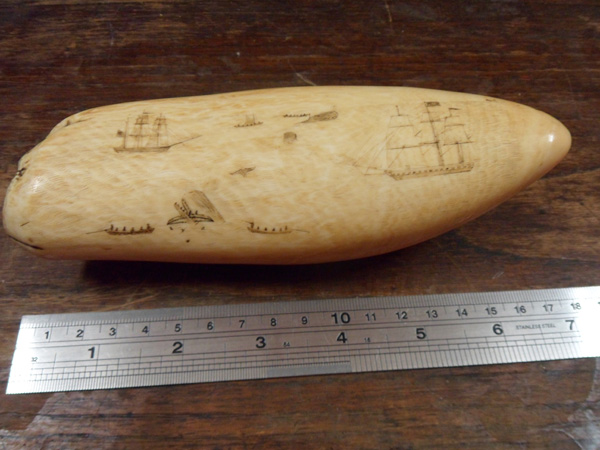Various
Relics of the Irish Whaling Industry
In the course of the Inventory Project five samples of whale products from Irish whaling vessels were catalogued.
By Wian Joseph
The specimens consist of five jars with cork stoppers measuring 18cm in height, with a 19cm circumference. There are three samples of oil, which are of a thick gel-like consistency and reddish-orange in colour, and two samples of meat meal, which are of a grainy texture and reddish-brown in colour. All five specimens are preserved in alcohol.
The Natural History Zoological Register entry reads:
1938.46 Bottle of Spermacetti & body oil, mixed, of Sperm whale; Given by James Power; Antarctic
1938.47 Two bottles of meat Meal, made of whale beef; Given by James Power; Antarctic
1938.48 Bottle of Whale Oil, Blubber; James Power; Antarctic
1938.49 Bottle of Whale Oil, Bone; James Power; Antarctic
[…] Material came from three factory whaling ships owned by Messers Salvesons of Leith, Scotland & registered in Dublin […]These factory ships operated under Irish (Dublin) register during the years 1937 & 1938
Whaling
In Europe whaling was first recorded around the time of the Norse Vikings of Scandinavia between AD800 and AD1000. Early whaling concentrated on deliberately trying to drive whales ashore and focused mainly on slower moving species that came close to shore. Species such as Right Whales were extensively targeted, so-called because they were the ‘right whales’ to hunt, as they are slow-moving and floated after death due to their high oil content. Throughout the decades as the capabilities of vessels developed so did the whaling industry, then finally in 1925 the first modern factory ship started to operate. With the technological improvements came the expansion of the European whaling industry, spreading from the North East Atlantic to the rest of the world, and finally reaching the Antarctic.
How whales kept Europe afloat
In the late 18th early 19th centuries whale products were a vital resource for Europe. Whale oil was used mainly for lighting prior to petroleum, but was also used in the manufacture of soaps, margarine, nitro-glycerine and many other products. Sperm oil, produced solely from toothed whales such as Sperm Whales, was used mainly for lubrication of machinery in the textile, cosmetic and leather industry as well as in the production of cosmetics themselves. Whale flesh was used for human consumption, animal food and fertiliser. The skin of the toothed whales was used as leather. Hormones and vitamins were extracted from various organs. Tendons were used for tennis rackets and surgical stitching. Baleen treated with steam could be bent into any shape desired and was used extensively prior to plastics, for everything from springs in the earliest typewriters to stay-rods in corsets and much more. Ambergris a concretion originating in the intestine of the Sperm Whale was used as a stabiliser for the more volatile components of top quality perfumes. Also, whale bones and teeth were used much like ivory to make novelty items such snuff boxes, paperweights and pistol grips. Below you can see an example of a decorative whale tooth carved with a whaling scene.

Figure 2: Decorative whale tooth carved with a whaling scene (NH:2008.85.699)
The decline of whaling
By the mid-19th century the demand for whale products had decreased significantly coupled with a marked reduction in the population of the great whales, causing the whaling industry to dry up. Alternatives to whale products such as vegetable and fish oils became more readily available. Simultaneously, the reduction in whale population sizes caused an outcry from the scientific community, calling for restrictions and eventually cessation of whaling. This finally caused the collapse of industrial whaling, and today several species are protected under the CITES (the Convention on International Trade in Endangered Species of Wild Fauna and Flora) agreement.
Why are these samples such an important part of our collection?
These samples represent an important historical reference for the collection, as Irish whaling factory ships are no longer in operation and whale populations are stringently monitored internationally, it would be impossible to replace or duplicate the specimens in our collection.
Learn more…
These specimens are not on public display as they part of the museum’s reserve collections. Related specimens can be viewed in the Mammals of the World exhibition on the first floor of the Natural History Museum, where there is whale skeletal material, baleen, alcohol preserved specimens and ambergris on display.
Read more about whales and the whaling industry
Evans, Peter G.H. (1987). The Natural History of Whales and Dolphins. Academic Press, Kent.
Tønnessen, J.N. and Johnsen, A.O. (1982). The History of Modern Whaling. University of California Press, Berkeley and Los Angeles.
Fairley, James S. (1981). Irish whales and whaling. Blackstaff Press, Belfast.
Location:
Relics of the Irish Whaling Industry is located at:
In Storage
Previous artefact:
Next artefact:
